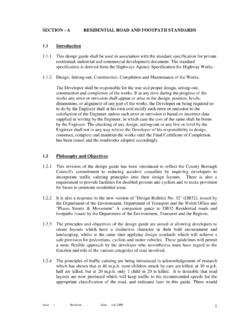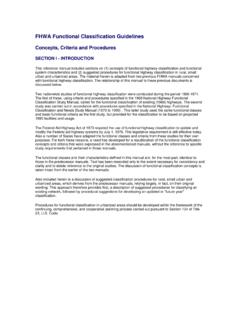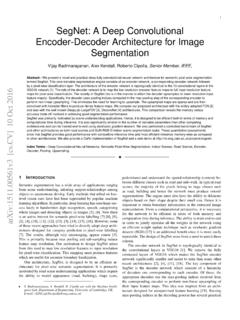Transcription of Guidance on road classification and the primary route network
1 Do not remove this if sending Page Title Guidance on road classification and the primary route network January 2012. Contents 3. 1. Definitions and principles .. 4. primary route network .. 4. Roads classification .. 6. Strategic road network .. 7. Local Highway Authority Responsibilities .. 7. 2. primary route network .. 8. Selecting a primary route .. 9. Appeals .. 11. Applicability .. 12. 3. road classification .. 13. Setting road classifications .. 13. Appeals .. 18. Applicability .. 19. Appendix A 20. road types - official .. 20. road types - unofficial .. 21. Other terms .. 22.
2 Annex A primary Destinations .. 23. 2. Introduction 1. The classification of Britain's roads dates back to the 1920s, when it had become clear that it was necessary to have a system to help motorists identify good routes for driving. In the 1960s, the existing system was overhauled to help deal with an age of mass-motoring. 2. From April 2012, central government will be handing over greater responsibility to local highway authorities for the management of the roads classification system. While authorities had previously done the majority of the work involved in reclassifying a road , they always needed to secure the agreement of the Department for Transport.
3 Under the new approach, authorities are allowed to exercise this power without the need for central approval. 3. Coupled with this, central government is also giving local highway authorities greater responsibility in the management of the primary route network (PRN). Again, all changes to this network previously needed to be approved by the Department. Under the new approach, authorities will have greater freedom to reorganise the PRN. 4. Management of the strategic road network (SRN) remains the responsibility of the Highways Agency. 5. The Government consulted on these proposals in February 2011 and issued a consultation response in December of the same year.
4 6. This Guidance sets out how local highway authorities should approach the classification of roads and the organisation of the PRN in their own area. 3. 1. Definitions and principles To the user, the road network is a single entity. In order to help motorists navigate from one place to another, and to help with effective management of the network , there are three systems through which roads are organised and classified nationwide - the strategic road network , the primary route network and roads classification . Of these, the primary route network and roads classification are the focus of this Guidance .
5 primary route network The primary route network (PRN) designates roads between places of traffic importance across the UK, with the aim of providing easily identifiable routes to access the whole of the country. primary routes are marked green on most road maps, as opposed to the more common red of an ordinary A road ; and road signs are green with white and yellow text. The PRN is constructed from a series of locations ( primary destinations). selected by the Department for Transport, which are then linked by roads ( primary routes) selected by the local highway authority. The PRN links together the whole of England, including areas that do not contain significant population.
6 Outside of national parks, few places in England are more than ten miles from a primary route . A motorist making a regional or national journey should therefore be able to make all but the start and finish of their journey using the PRN should they wish. The PRN is a devolved matter. Several primary routes run between England and Scotland or England and Wales, meaning cooperation between highways bodies across borders is required. primary Destinations The criteria for defining a primary destination are purposefully flexible, in order to allow the PRN to serve the whole of the country.
7 Strict criteria based on population size or traffic levels would prevent the PRN. reaching more rural corners of the country. The inclusion or exclusion of 4. individual locations is therefore a matter of DfT discretion, taking the following factors into account: Population the size of the settlement example Cheltenham Attraction the amount of traffic that will come to this location example Stansted Airport Nodes locations that motorists are very likely to pass through in order to get to a final destination example Scotch Corner Density the number of primary destinations in the area.
8 Example as Stevenage is a primary destination, neither Letchworth Garden City nor Hitchin need to be. A primary destination does not refer to a specific point on the ground. The end-point of a primary route is likely to depend on the layout of the road network . In some cases, it may also reflect a decision about what is the most important location nearby - for example, Grimsby could refer to the town or the major port. It is for the local highway authority to decide where the primary route should end, consulting with nearby authorities and the Highways Agency where they are affected.
9 Onward signing should be provided where appropriate. The list of primary destinations in England can be found in Annex A. The Department for Transport is responsible for maintaining and updating the list. Definition of a primary route All primary routes (other than those included on the PRN because they are trunk roads1) consist of an A road or sequence of A roads, forming a continuous route between two primary destinations. The route does not need to have the same numbering between its two destinations, but it should be signed in a way that assists motorists in finding the way to the relevant primary destination (see paragraph ).
10 A primary route will often pass through the jurisdiction of several highways authorities. In these cases, it is recognised that all authorities along the route have a stake in its successful operation. Authorities 1A trunk road is a road owned and operated by the Secretary of State for Transport. Trunks roads form part of the Strategic road network (see para ). 5. making changes to a route affecting other authorities should follow the principles laid out in Chapter 2. Roads classification The system of roads classification is intended to direct motorists towards the most suitable routes for reaching their destination.














